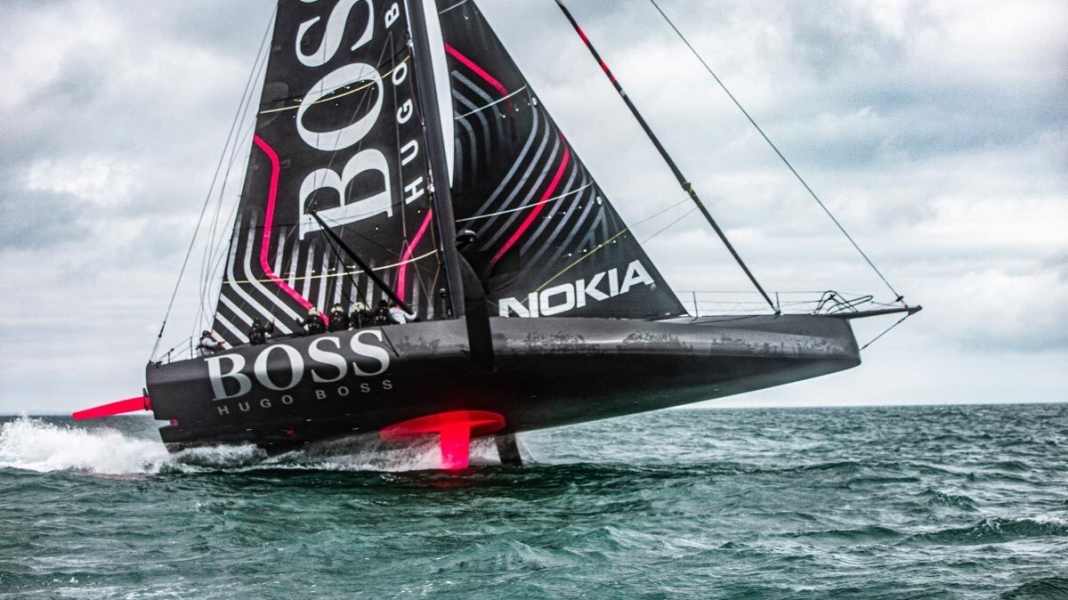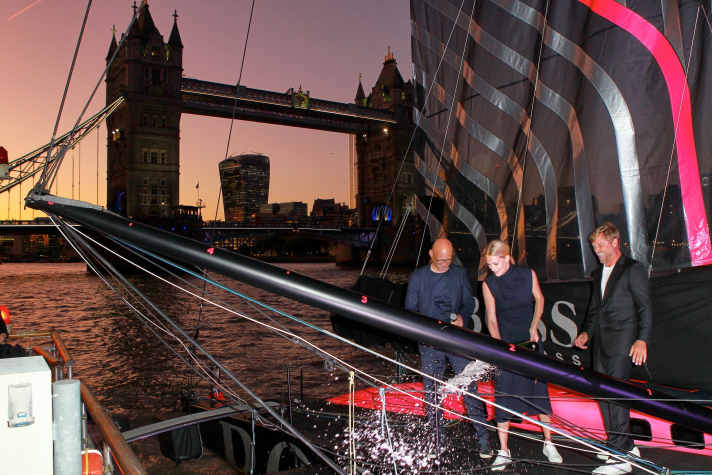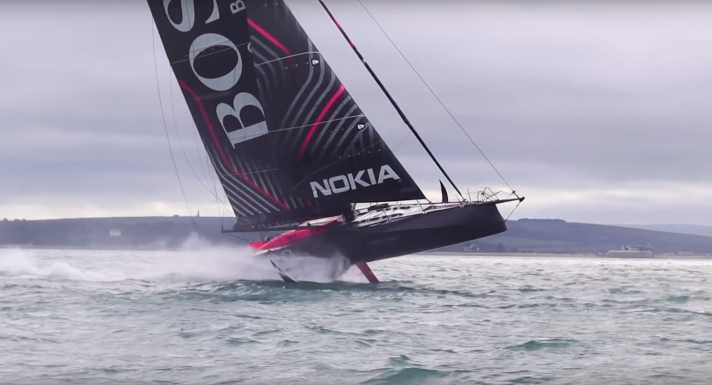
These are the first sailing pictures of what is probably the most eagerly awaited boat on the Imoca scene: the new "Hugo Boss", with which Alex Thomson has declared his intention to win the Vendée Globe. Last night, the black and pink Open 60 was christened by model Poppy Delevingne together with Boss CEO Mark Langer and skipper Alex Thomson. Celebrities and sailing greats such as Robin Knox-Johnston and Nico Rosberg attended the event on the Thames alongside the designers from VPLP and designer Karim Rasshid, who developed the visual design.

Spectacular video of the first test drives
YACHT previously had the opportunity to take a tour of the boat with skipper Thomson. The foils, the centrepiece of the racer, were also on show for the first time. The first spectacular videos of the boat sailing show that the boat comes out of the water extremely high and foils very stably - much more consistently than its current biggest competitor, Jeremy Beyou's "Charal".
And the swords are indeed a surprise: the huge, almost circular, enormous profiles are seven and a half metres long, around two metres longer than those of the old "Hugo Boss", and are probably the largest in the entire IMOCA class.

Alex Thomson summarises their advantages as follows. "There are quite a few: the boat is more stable than on foils with several angled sections and, unlike some other teams, we can retract it completely. This makes the boat faster in light winds."
What's more, since a rule change in the Imoca class, the foils can also be adjusted in the longitudinal axis, allowing the lift to be controlled in a similar way to landing flaps on an aeroplane. An important tool for foiling earlier than with the previous generation.
The most striking feature of the boat, however, is the completely covered deckhouse with 20 square metres of solar panels. The skipper really has to climb inside through a tiny entrance under the mainsheet traveller.
The reasons for this are complex. "Sailing these boats is brutal: there's a lot of water coming over you, the spray is constantly hitting you in the cockpit and you're often in freezing water in the Southern Ocean. I'm better protected this way." Other advantages include a lower centre of gravity in the boat and better aerodynamics. Anyone entering Thomson's working and living space will find a boat divided into two sections: After the hatch is a vestibule with a step under which the charging electronics and battery banks as well as the keel hydraulics are housed.
Thomson also has an electric motor on board instead of a diesel engine. The first tests worked excellently, but a tiny diesel generator is still on board as a backup for generating electricity.
Another watertight hatch leads from this pitch-black carbon fibre vestibule into the heart of the boat, a compact trim and lookout centre. "Everything I need to sail the boat is concentrated here: four winches, a grinder and, if necessary, a tiller for steering. Three mobile cameras allow me to see the sails at all times." The embrasure-like windows at the front provide a good view ahead. All lines are diverted to this command centre.
However, photos are banned almost everywhere. The team protects its own technical solutions from the competition. "The Vendée is of course also a design race, just like the America's Cup." He wants to maintain the team's lead, which almost always takes different, radically new paths, for as long as possible - at least until competing teams can no longer react in time.
And the initial tests make him optimistic that he has succeeded in building a boat that is faster than the competition, just like the last Vendée. " The new 'Hugo Boss' foils much more stable than the previous one. "We've only sailed for twelve hours so far, but we were easily travelling at 32 knots in 18 knots of wind!" But the Vendée is not a top speed race; what counts are high average speeds. Thomson is optimistic that they will be 15 to 20 per cent faster than the previous boat.
The first results will come from the transatlantic Jacques Vabre, which Thomson will start in October with co-skipper and Volvo Ocean Race legend Neal McDonald.
It takes about a year to make an Open 60 reliable and realise its full potential, because after a third and second place at the Vendée, everything in Thomson's life revolves around finally winning. The French offshore elite gathered there are likely to have their work cut out to stop the Brit from doing so this time too. Last time it was a piece of driftwood that broke Thomson's foil and denied him victory. If that hadn't happened, Armel L'Cléach would hardly have caught up with the Briton, who had been the clear leader until then.

